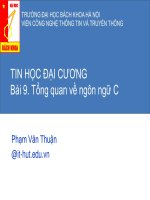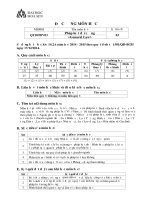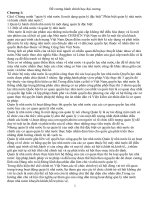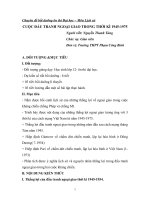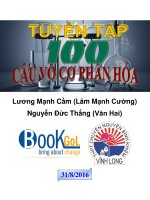Đáp án môn dịch đại cương ehou đại học mở
Bạn đang xem bản rút gọn của tài liệu. Xem và tải ngay bản đầy đủ của tài liệu tại đây (108.41 KB, 45 trang )
1. The structures of …………………………………. will be preserved as closely as
possible but not so closely that the target language structure will be seriously distorted.
a. the source language Câu trả lời đúng
b. target
c. Clause
d. sentence
2. Translation is the expression in another language (target language) of what has been
expressed in one language (source language), preserving…………………………
a. All the features of words and phrases, not the whole sentence.
b. semantic and stylistic equivalencies. Câu trả lời đúng
c. The simplest form of the language in communication
d. Only the best meanings of the texts
3. The translator discovers the meaning behind the forms in the source language and does
his best to produce the same meaning ……….
a. Outside the source text
b. Out of the source text
c. in the target language Câu trả lời đúng
d. in the source language
4. The predominant purpose of theories of translation is ………………… of every word
and phrase in the original.
a. To do a lot of translating
b. to express as exactly as possible the full force and meaning Câu trả lời đúng
c. To get as many meanings as possible
d. To do a good job
5. Translation it must be conceived as an integral communicative
…………………………….
a. Performed
b. Performance Câu trả lời đúng
c. performing
d. Performative
6. Translation theory includes principles for translating figurative language, dealing with
lexical mismatches, rhetorical questions, inclusion of cohesion markers, and …..
……………………
a. Other fields to complete the process.
b. To give translator a chance
c. A lot of work to do
d. many other topics crucial to good translation. Câu trả lời đúng
7. The source-language content, form, style, function, etc. must be preserved, or at least that
the translation must seek ………………………them as far as possible.
a. preservation
b. Preserve
c. to preserve Câu trả lời đúng
d. Preserving
8. Translation should ensure that the ……………………meaning of the two will be
approximately similar.
a. abstract
b. indirect
c. surface Câu trả lời đúng
d. different
9. There are a variety of cultural elements to take into …………………..when starting a
translation.
a. consideration Câu trả lời đúng
b. Consider .
c. Considering
d. Considered
10. The linguistic approaches basically saw translating as …………………
a. A good way of communication
b. A subject of study
c. a code-switching operation. Câu trả lời đúng
d. An authentic way of expressing ideas.
11. In addition…………..the changes resulting from the movement from one language to
another, translation necessarily changes the receiver or addressee of the text.
a. of
b. to Câu trả lời đúng
c. on
d. for
12. The source text is the text which has been chosen for translation. The translator cannot,
without a good reason, change any………………..
a. Meaning of the text
b. Element of the text
c. part of the source text. Câu trả lời đúng
d. Topic of the text
13. The translator, like the linguist who …………..all human languages to be on an equal
footing, is among the first candidate to be liberated from the dominance of one
language/culture
a. taken
b. took
c. taking
d. takes Câu trả lời đúng
14. ………………. is the language to which the text to be translated belongs. In other words,
the source language is prior to translation.
a. The language form
b. The source language Câu trả lời đúng
c. The foreign language
d. The first part of the language
15. ………………………………….is the interpreter of the source text, and the producer of
the final interpretation which determines the meaning(s) which readers of the translation
will read.
a. The translator Câu trả lời đúng
b. The writer
c. The reseacher
d. The teacher
16. A simultaneous translator changes what ……………………in one language into another
language as someone is speaking.
a. is being said Câu trả lời đúng
b. Was being said
c. Has been said
d. Have been said
17. The source language, as has been seen earlier, is not only the very central and initial point
for the …………….of the translation process but also is the background for all
translation processes.
a. started
b. To start
c. Start Câu trả lời đúng
d. Starting
18. The translator's judgments, strategies and manipulations ………………all potentially
exist in the translator's interpretation of the source text and the formulation of the
translated text which is governed by the target language.
a. Done
b. Do Câu trả lời đúng
c. Did
d. Does
19. For simultaneous interpretation, microphones, earphones and a booth are necessary
……………….
a. technical equipment. Câu trả lời đúng
b. Electrical devices
c. Domestic tools
d. Machines
20. Typically, two interpreters are placed together in a booth, and they follow an audio-
transmission of speeches and …………………….
a. interpret them directly. Câu trả lời đúng
b. Doing the interpretation
c. Translate all the things
d. Interpreting the talks
21. Adaptation is a highly free type of translation. Here the focus is on socio-cultural
phenomena or ………………that are absent in the target culture.
a.Works
b.Drillings
c.practices Câu trả lời đúng
d.Trainings
22. It is also very useful for the translator to understand and analyze the original text before
…………...it into the target language.
a. translating Câu trả lời đúng
b. Turning
c. Exchanging
d. Changing
23. It is also very useful for the translator ……………………and analyze the original text
before translating it into the target language.
a.to understand Câu trả lời đúng
b.to understanding
c.Understanding
d.Undertood
24. …………………………………………is featured by the fact that grammatical structures
and the meaning of words are translated almost as closely as those in the target language
without paying attention to the situation or context .
a. Faithful translation
b. Semantic translation
c. Literal translation Câu trả lời đúng
d. Communicative translation
25. Communicative translation gives high priority to the message communicated in the text
where the actual form of the original is not closely bound to …………………..
a. its intended meaning Câu trả lời đúng
b. Forms
c. Structures
d. Intention
26. As indicated by the word “free”, free translation (sometimes dynamic translation) focuses
more ……..………………..than form in the target language
a. On meanings
b. On words
c. on content Câu trả lời đúng
d. On structures
27. Different strategies or different methods of translation produce ………………. kinds of
translation.
a. Differ
b. differently
c. Difference
d. Different Câu trả lời đúng
28. In other words, adaptation translation aims to create an equivalence of the same value
……………………. to a different situation.
a. Applicable Câu trả lời đúng
b. Application
c. Applicant
d. Apply
29. In the history of translation development there have been a great number of terms: literal,
free, literary, non-literary, borrowing, equivalence, figurative, so on …………………….
a. and so forth. Câu trả lời đúng
b. And so hot
c. And so long
d. And so far
30. Faithful translation can be described as one kind of translation which tries ………of
words and context situation according to the grammar rules of the target language.
a. To change the meanings
b. to convey the meanings Câu trả lời đúng
c. To find out the menaings
d. To create the meanings
31. The choice of the right word in the receptor language to translate a word in the source-
language text depends more ……………........ …………………than upon a fixed system
of verbal consistency.
a. on the context Câu trả lời đúng
b. About the source text
c. At the context
d. With the meaning of the text
32. The theory of translation involves normative approaches, putting a strong emphasis on
prescribing to translators how to and ……………
a. What to translate
b. Where to translate
c. how not to translate. Câu trả lời đúng
d. translating
33. Translation has become popular in language learning and daily life. So far, there have
been ……………………………………definitions of translation.
a. 17
b. many Câu trả lời đúng
c. 20
d. 18
34. he instructor can then hope to measure the students’ linguistic competence by
…………….
a. Practising more and more
b. Asking some questions
c. means of the target language products. Câu trả lời đúng
d. Encouraging them to work more
35. This means that the translator has, ………………….the pressure of deadlines, more time
than the interpreter (especially the simultaneous interpreter) to process the source text
thoroughly .
a. though
b. although
c. Despite Câu trả lời đúng
d. In spite
36. To have interpretation as precise as possible, they should make regular shorter breaks to
enable the interpreters …………………….the message in the same spirit.
a. to relay Câu trả lời đúng
b. To reproduce
c. To justify
d. To change
37. The translated text is the actual definite material, which has been produced by
……………………..of a source text in terms of another language and culture.
a. Analysing the text
b. conveying the meaning Câu trả lời đúng
c. Producing the context
d. Reviewing the contents
38. It goes without saying that all the types of translation mentioned above may …………..
justified in particular circumstances.
a. is
b. was
c. been
d. be Câu trả lời đúng
39. Semantic translation focuses to a great degree on ………………..…………..and form
(syntax) of the original texts of high status
a. Contents
b. Words and phrases
c. meaning (semantic content) Câu trả lời đúng
d. Structures
40. ………………………………….is based on the meaning of the text which aims to
produce the message of the original but tends to distort nuances of meaning by using
idioms and colloquialism where there do not exist in the original.
a. Faithful translation
b. Communicative translation
c. Idiomatic translation Câu trả lời đúng
d. Semantic translation
41. In this situation the translator’s task is recreate some form of language
………………………. the same meaning.
a.To follow
b.To change
c.To correct
d.to convey Câu trả lời đúng
42. Semantically, the meaning of a word includes a number of meaning components
classified as things, events, attributes or relations which are combined ………………
lexical items.
a. Under
b. about
c. for
d. into Câu trả lời đúng
43. English vocabulary mostly consists in single words, but ……………..…..of multiword
vocabulary is not small.
a. the amount Câu trả lời đúng
b. The figure
c. The fact
d. The number
44. Figurative meaning is based on or makes use of figures of ……............such as metaphor
(an implied comparison between two things with the same characteristic.
a. Speech Câu trả lời đúng
b. Listening
c. speak
d. Writing
45. here are some word classes that are only typical in certain languages, so the number of
word classes in all languages is not similar and their …………………are not the same.
a. Syntactic functions Câu trả lời đúng
b. Relationship
c. structure
d. grammartical context.
46. Polysemes can be compared with homonyms, which are words with several
…………………meanings
a. Unrelated Câu trả lời đúng
b. Popular
c. Direct
d. Common
47. English prepositions are usually single words in, at, on...; …………, there are some
prepositions that look like a phrase, phrasal prepositions: because of, in spite of...
a. However Câu trả lời đúng
b. Further more
c. Additionally
d. More over
48. Syntactical forms which …………. used to express grammatical meanings of the verb in
English sentences are obligatory,
a. Is
b. Has been
c. been
d. are Câu trả lời đúng
49. As can be seen from above, the English sentence is mechanically indicated by means of a
period/stop (.), a question mark (?) or an exclamation mark (!) - never by a comma (,) ……………………..
a. at the beginning in writing
b. at the end in writing Câu trả lời đúng
c. In the middle in writing
d. by the end in writing
50. The translator should remember …..…………. the zero article with plural count nouns in
English to mean generally
a. Usage
b. Use
c. Using
d. to use Câu trả lời đúng
51. There is no article in Vietnamese whereas the ………….of article: indefinite articles a,
an, definite article the, or zero article is a must in English noun phrases.
a. Used
b. Usage
c. Using
d. Use Câu trả lời đúng
52. Translators should define proper verbs of English to go with the subject, either
…………………….: be, get, become... or action/dynamic verbs run, work... to follow the
subject.
a. Transitive verbs
b. linking/static verbs Câu trả lời đúng
c. di-transitive verbs
d. Mono-transitive verbs
53. A sentence is a group of words conveying a complete idea which normally contain a
subject and a verb predicate………………...
a. In good forms
b. In various forms
c. In negative forms
d. in “finite” forms Câu trả lời đúng
54. The …………………………….in the English sentence usually stands right after the
subject, giving information about the subject.
a.Verb form
b.verb predicate Câu trả lời đúng
c.Verb patterns
d.Verb phrase
55. As for noun phrases (NP), the noun (common noun: love, proper noun: Mai, and
pronoun: you) is ………of the phrase.
a. Head Câu trả lời đúng
b. Arm
c. Hand
d. Leg
56. It is ………………..that in an English sentence the predicate verb (V) be in finite forms,
the predicate agreeing with the subject in person and number
a. Obligatory Câu trả lời đúng
b. Strange
c. New
d. Bad
57. Translators should use procedures of transposition to render from the Source Language
texts ……………………………..as to suit the Target Language grammar rules.
a. in such ways Câu trả lời đúng
b. in such a way
c. in many ways
d. in several ways
58. Coordinating conjunctions are only in mid-position whereas ………………………
conjunctions can be in initial or mid-position in the sentence.
a. subordinate
b. Subordinative
c. Subordinating Câu trả lời đúng
d. Subordination
59. Translators should define both subject and verb predicate at …………….. time if they
want to translate a sentence.
a. The nice
b. The big
c. The good
d. the same Câu trả lời đúng
60. In English-Vietnamese translation of the predicate verb, the meanings of time and aspect
can ……………………to such words as đã, sẽ, sắp, đang...
a. Suitable
b. Go
c. Respond
d. Correspond Câu trả lời đúng
61. In English, the …………….. phrase can be used after a verb, an adjective, or a noun and
depend on them.
a. prepositionally
b. Prepositional Câu trả lời đúng
c. prepositions
d. preposition
62. ……………………..in the English sentence is usually a noun phrase, pronouns, proper
names, to-infinitives, gerunds, or clauses
a. The subject Câu trả lời đúng
b. The adverb
c. The clause
d. The predicate
63. There will be words which …………….some of the meaning components combined in
them matching a word which has these components with some additional ones.
a. have Câu trả lời đúng
b. Had
c. Has
d. Having
64. Meaning components are ‘packaged’ differently in one language from another. That is
why the translator needs …………… to analyze the lexical items (words) of the source
text in order to translate them.
a. to be able Câu trả lời đúng
b. Have been able
c. Has been able
d. be able
65. In word formation, morphemes which occur at the end of a word are
called………………………….
a. prefixes
b. Suffixes Câu trả lời đúng
c. root
d. bound
66. literal meaning is direct, denoting what words mean according to ………………………..,
figurative meaning is indirect, connoting/implying some information
a. dictionary using
b. dictionary use
c. dictionary usage Câu trả lời đúng
d. dictionary uses
67. In Vietnamese, words that correspond to both lexical …………………. grammatical
words in English are numerous.
a. so
b. But
c. And Câu trả lời đúng
d. Or
68. Translator need revise the draft on the basis of the feedback received from those people
who may have suggested many…………………., changes, additions or omissions with
the translator.
a. Rewordings Câu trả lời đúng
b. Rewriting
c. Reworded
d. Rewrite
69. Translators have to make sure that they ………………….a text well in the original
language
a. Understanding
b. understand Câu trả lời đúng
c. To understand
d. Understood
70. The translator begins drafting the translation piece by piece, section
…………………………by using the lexis and structures
a. By phrase
b. by section Câu trả lời đúng
c. By step
d. By sentence
71. Once the translation is completed, the translator should revise it, rarely fewer than three
times and, ………………….., with a time lapse (after hours or even days) between
revisions.
a. when with possiblity
b. when possiblity
c. when possible Câu trả lời đúng
d. when possibly
72. Certain strategies ………………… those differences; for example, certain expressions or
key terms in their text-to-be need to be selected.
a. to deal with Câu trả lời đúng
b. Dealing with
c. To deal
d. Dealing
73. In the other theory of translation, the predominant purpose is ………………………… ,
but rather moves in its new dress with the same ease as in its native rendering.
a. to produce a result that does not read like a translation at all Câu trả lời đúng
b. To do the translation as quickly as possible
c. To convey the meaning of the whole text
d. To replace the new text with its direct meanings
74. Translation theory includes ……………………….for translating figurative language,
dealing with lexical mismatches, rhetorical questions, inclusion of cohesion markers, and
many other topics crucial to good translation.
a. Causes
b. Principles Câu trả lời đúng
c. Reasons
d. Results
75. Translation is the expression in another language (target language) of what has been
expressed in one language (………………………), preserving semantic and stylistic
equivalencies.
a. source language Câu trả lời đúng
b. Another language
c. First language
d. Second language
76. to translate means “……………... a text in a target setting for a target purpose and target
addresses in target circumstances".
a. to produce Câu trả lời đúng
b. To arrange
c. To get
d. To correct
77. The translated text is the actual definite material, …………has been produced by
conveying the meaning of a source text in terms of another language and culture.
a. Where
b. When
c. What
d. Which Câu trả lời đúng
78. …………………………………………to whom the translated text is addressed are
native or non-native users of the target language.
a. The reporters
b. The readers Câu trả lời đúng
c. The interpreters
d. The translators
79. In English, the negation of the verb in the first clause stands for …..……………….in the
following clause.
a. the negation of the auxiliary verb
b. The affirmative form of the verb
c. the negation of the verb Câu trả lời đúng
d. the positive form of the verb
80. …………………………………………………………… translation (or sometimes
direct/interlinear translation) focuses on translating words from the source text into the
target language while the word order of the original is preserved.
a. Word for word Câu trả lời đúng
b. Word by word
c. Word in word
d. Word with word
81. Adaptation can also be considered a translation technique used when the context in the
original text ……...……………………………. in the Target Text culture.
a. does not return
b. does not exist Câu trả lời đúng
c. does not work
d. does not run
82. Connotation is subjective by the language users, and can be influenced by
……………………...
a. Many objects
b. Many subjects
c. many factors Câu trả lời đúng
d. Many methods
83. In word formation, morphemes which occur at the front of a word are called
……………………….
a. Suffixes
b. Inflectional
c. prefixes Câu trả lời đúng
d. root.
84. However, grammatical words in general and articles and prepositions in
………………..might cause headache to translators.
a. particular Câu trả lời đúng
b. deed
c. Time
d. fact
85. The first step in the analysis of words is to determine whether the word is referring
primarily to a thing concept,…………….. event concept, an attribute concept, or a
relation concept.
a. an Câu trả lời đúng
b. A
c. the
d. Zero
86. The ................ of words in Vietnamese does not seem to be so distinctive: word classes
do not have their typical forms, their forms never change in the sentence.
a. Classes
b. Classify
c. Classification Câu trả lời đúng
d. class
87. When analyzing the text for translation ……………… the first time, the translator needs
to find answers to these questions:
a. with
b. Under
c. for Câu trả lời đúng
d. in
88. Remember that all of our verbalizing must be done in the target language now. We must
………………..between alternatives and produce a text that is sequentially complete.
a. Choose Câu trả lời đúng
b. To choose
c.
d. Choosing
89. He or she reformulates the translation according to the grammar rules, ……………..,
cultural norms in the target language.
a. word to use
b. word usage Câu trả lời đúng
c. word using
d. word use
90. If any key words are …………….., the text will need to be checked carefully for
consistency in the change made.
a. Changed Câu trả lời đúng
b. Changing
c. Change
d. To change
91. The linguistic approaches basically …………….. translating as a code-switching
operation.
a. Seeing
b. seen
c. Saw Câu trả lời đúng
d. Sees
92. A satisfactory translation is always possible, but a good translator is never satisfied
…………..it.
a. With Câu trả lời đúng
b. for
c. About
d. Of
93. whereas the interpreter is faced with a unique, orally delivered text, the translator has
……………………of "flicking back" through the permanently available written text.
a. The happiness
b. The difficulty
c. the possibility Câu trả lời đúng
d. The pleasure
94. The classifications of translation types are many according to different points of view,
based on either structure, function, or ………
a. Meaning
b. semantics of language. Câu trả lời đúng
c. Meanings
d. Meaningfulness
95. The translator tries to come as close as possible to the meaning conveyed by the words,
by means of word order change or word choice so that the true meaning is……………….
a. Used
b. Checked
c. conveyed. Câu trả lời đúng
d. done
96. There is some unusuality or ……………………. in the target language.
a. Nature
b. Natural
c. unnatural
d. Unnaturalness Câu trả lời đúng
97. Since figurative language is not intended to be interpreted in a literal sense, in
………………… figurative language, translators should make use of comparison
between different things
a. Translate
b. Translating Câu trả lời đúng
c. Translated
d. translation
98. there is a skewing between the semantic classification …………… the grammatical
classification. Some words are made up of more than one concept.
a. Or
b. And Câu trả lời đúng
c. but
d. nor
99. ……………………………...should be aware of the concepts muli-words convey and the
rules how to make and write compound words in English.
a. Translators Câu trả lời đúng
b. Doctors
c. Teachers
d. Workers
The stage of editing the translated text which ……………. the form of a careful
last-minute checking and correcting of possible mistakes or other inaccuracies is
implemented in most cases of translation.
100.
a. takes Câu trả lời đúng
b. Taken
c. Taking
d. Took
Faced by a text in a language, as student translators, you should analyze the text
by asking and …………………………….several questions.
101.
a. Answering Câu trả lời đúng
b. Answered
c. To be answering
d. Tobe answered
102.
There is any place where information has been added, omitted, or subtracted
a. subtracting
b. subtracted Câu trả lời đúng
c. To subtract
d. Substract
103.
The forms are ……………… to as the surface structure of a language.
a. Referred Câu trả lời đúng
b. refer
c. Reference
d. Referring
Since the mid-1970s the name ‘Translation Studies’ has been adopted to indicate
that the …….……………………………………………………….is not just a minor
branch of comparative literary study, nor yet a specific area of linguistics, but a vastly
complex field .
104.
a. Field of translation
b. Method of translation
c. Way of translating
d. study of translation Câu trả lời đúng
The producer of the final interpretation …………………… determines the
meaning(s) which readers of the translation will read.
105.
a. When
b. What
c. Which Câu trả lời đúng
d. Where
